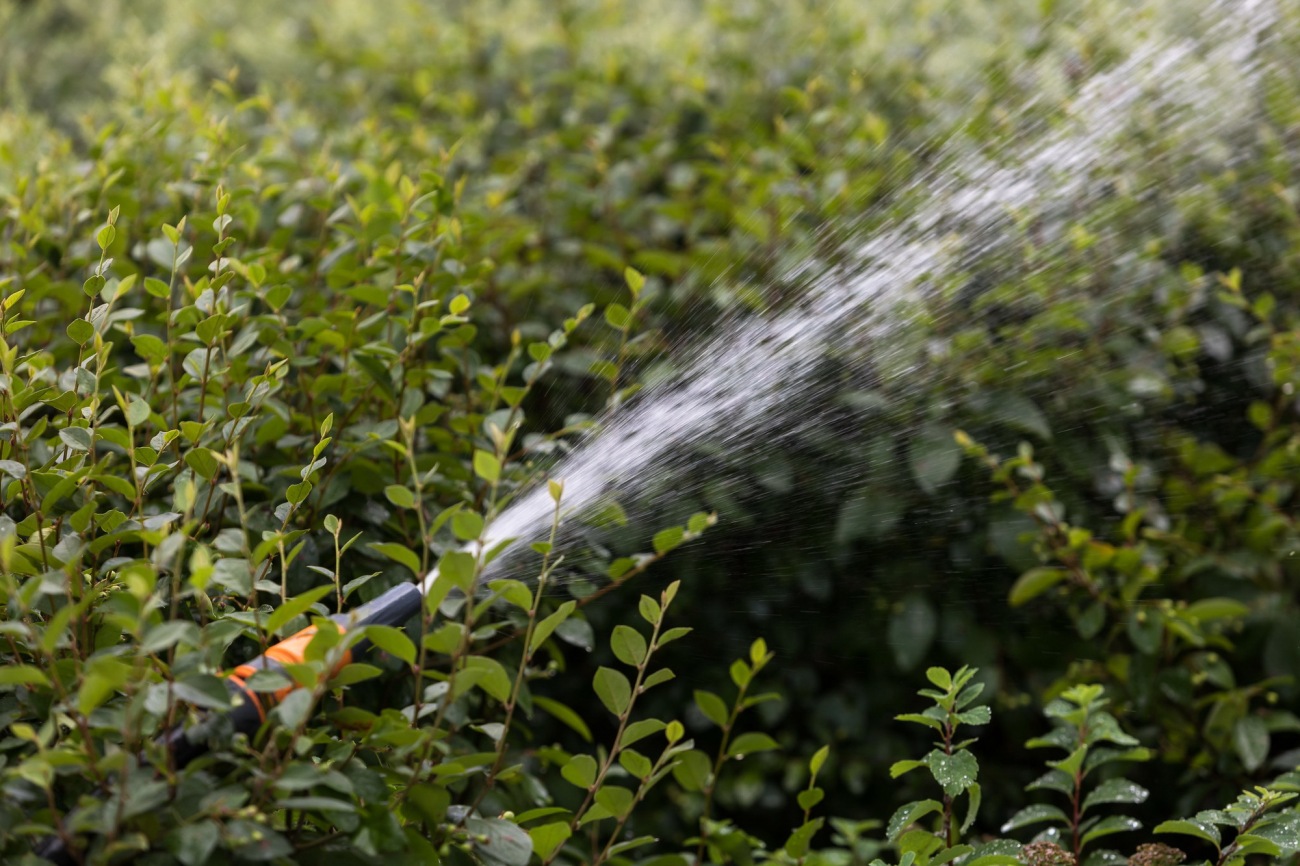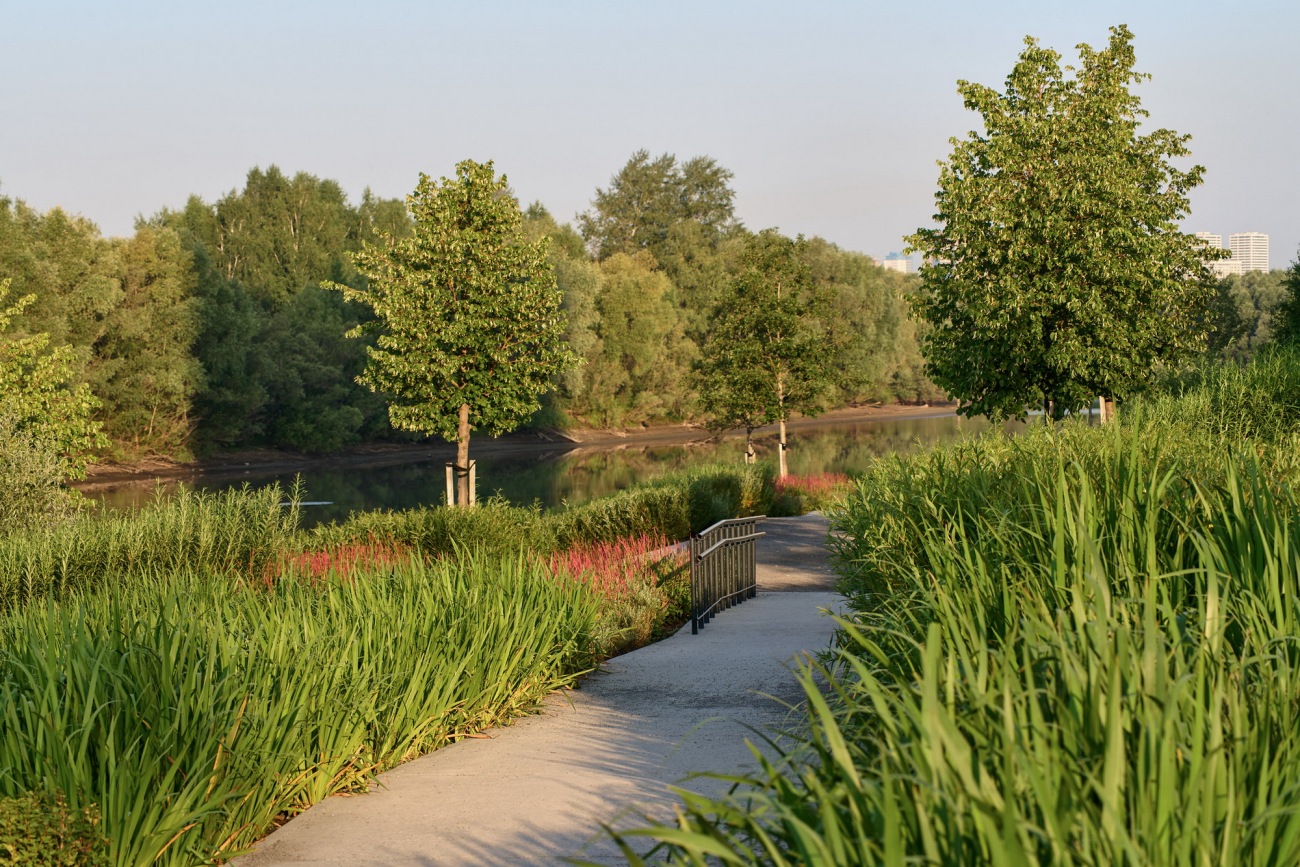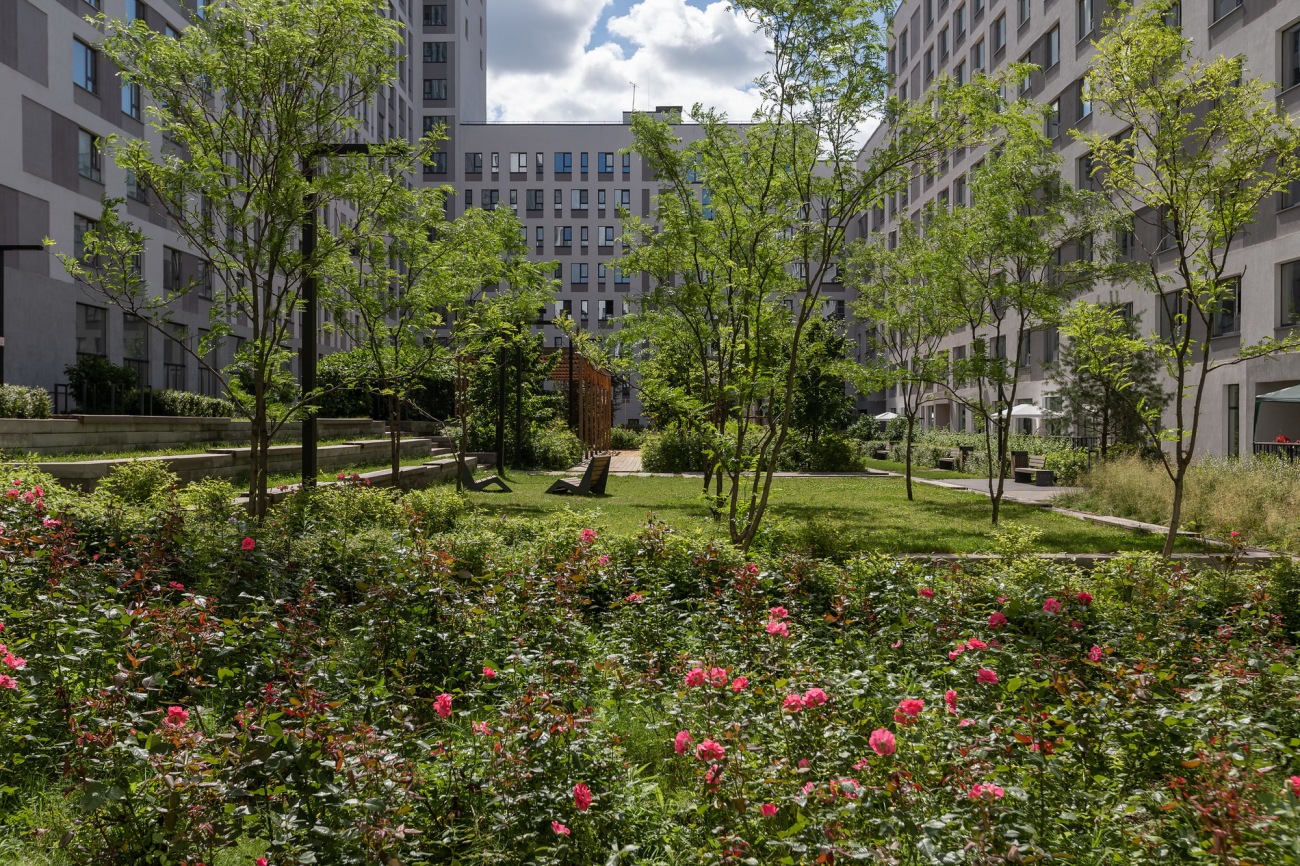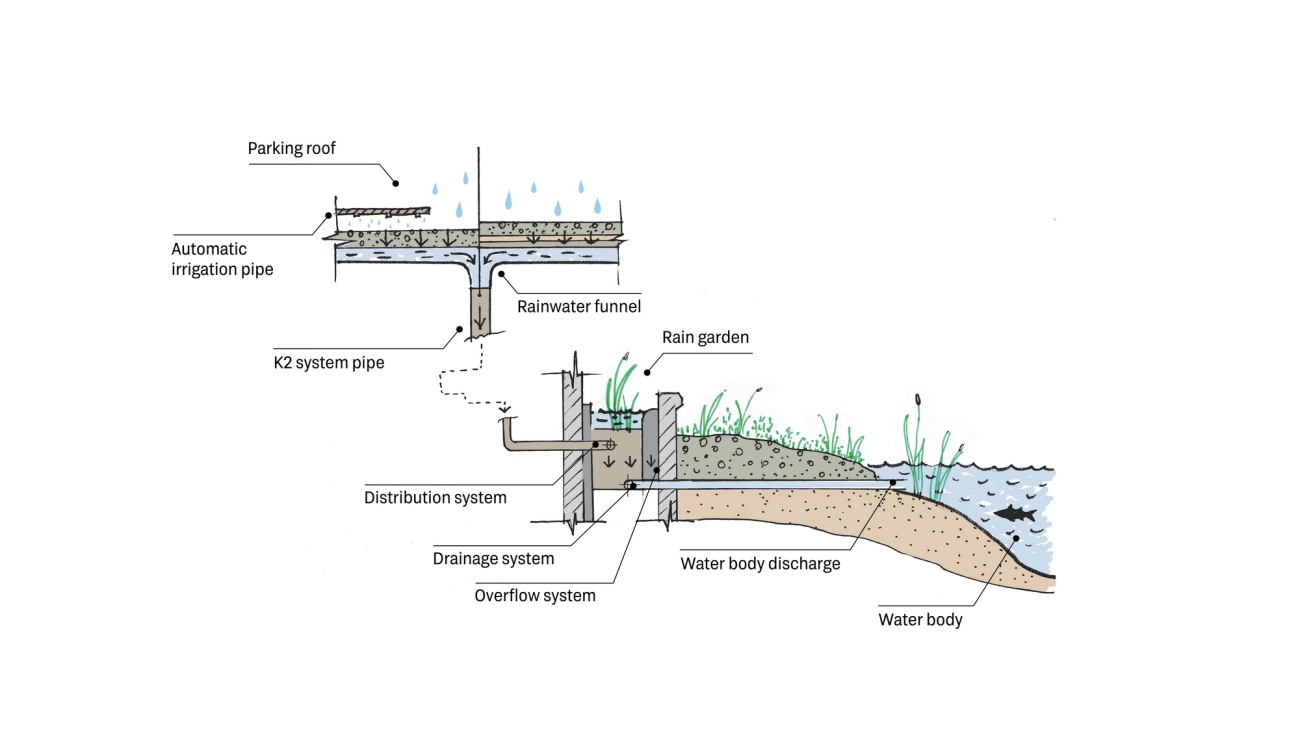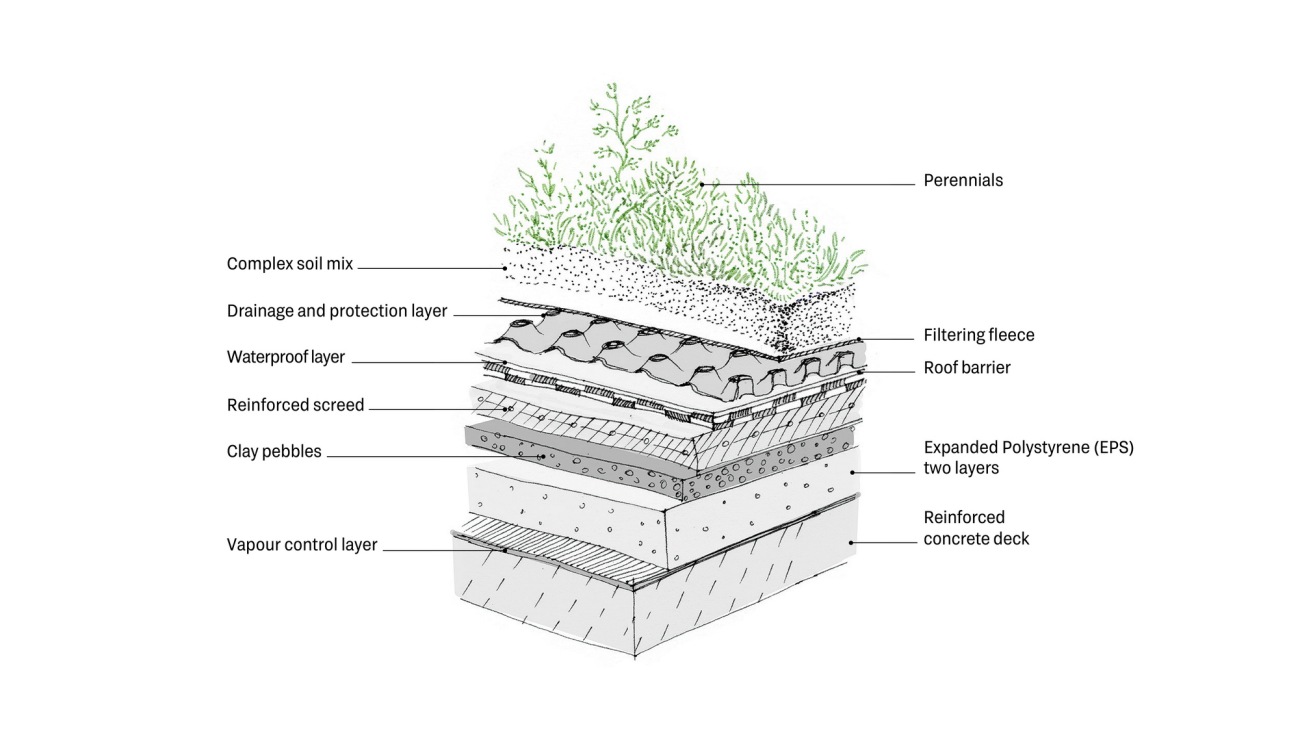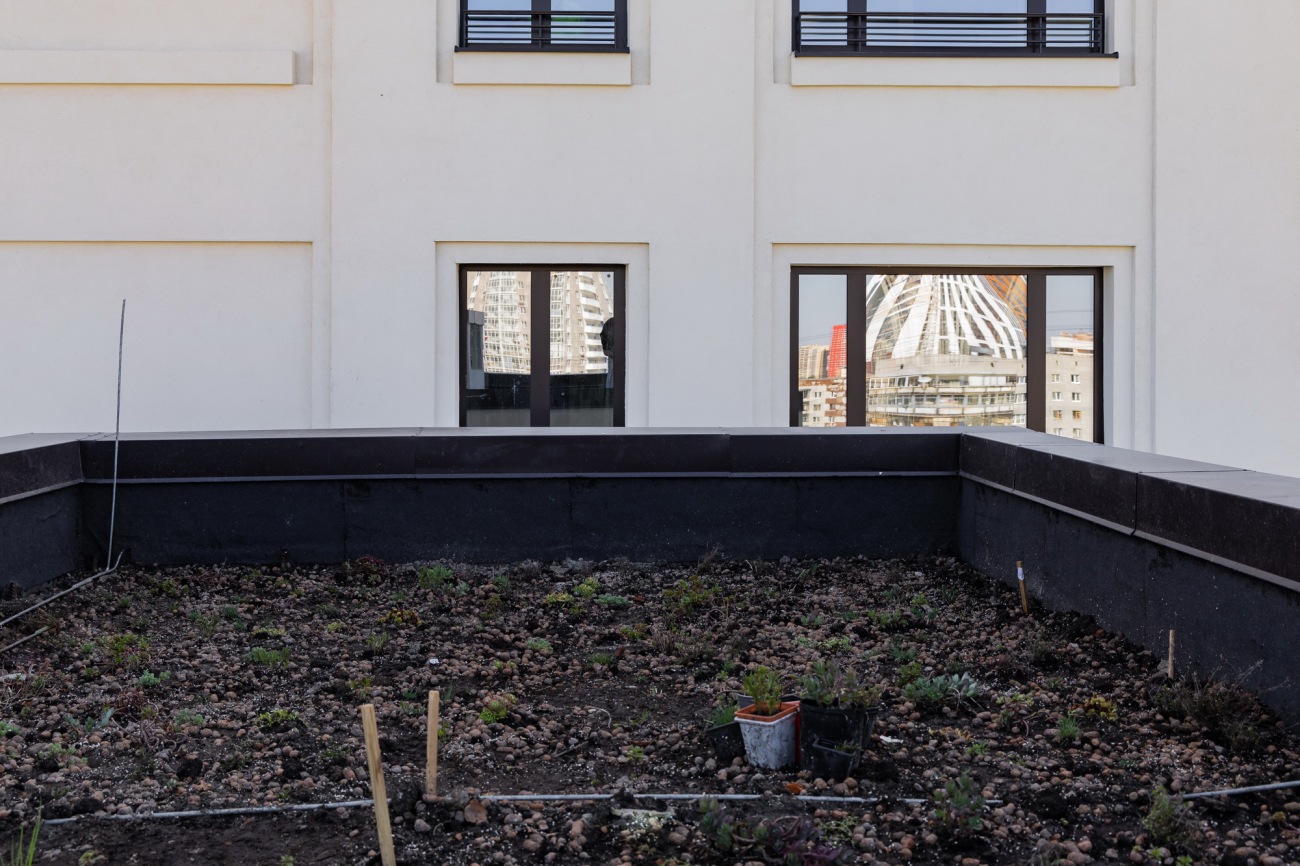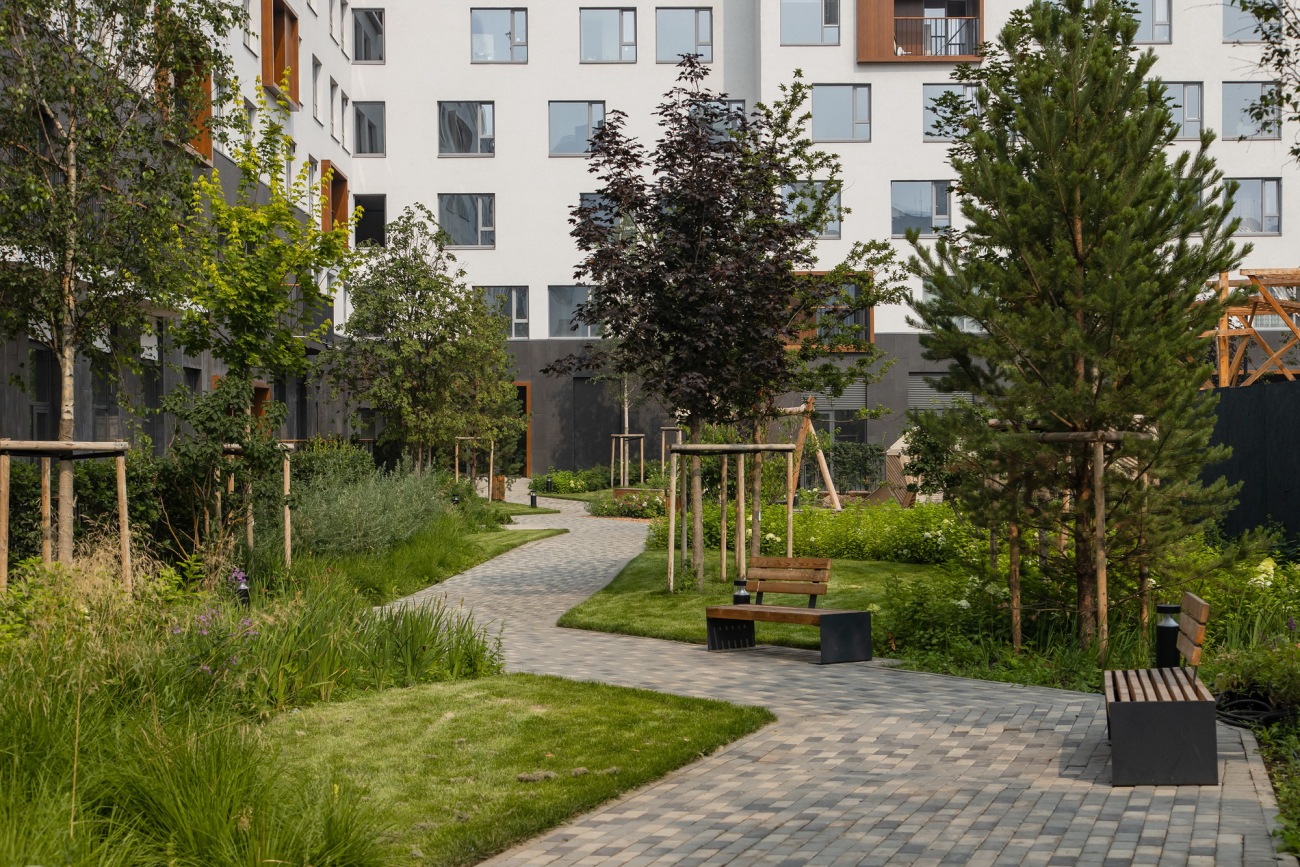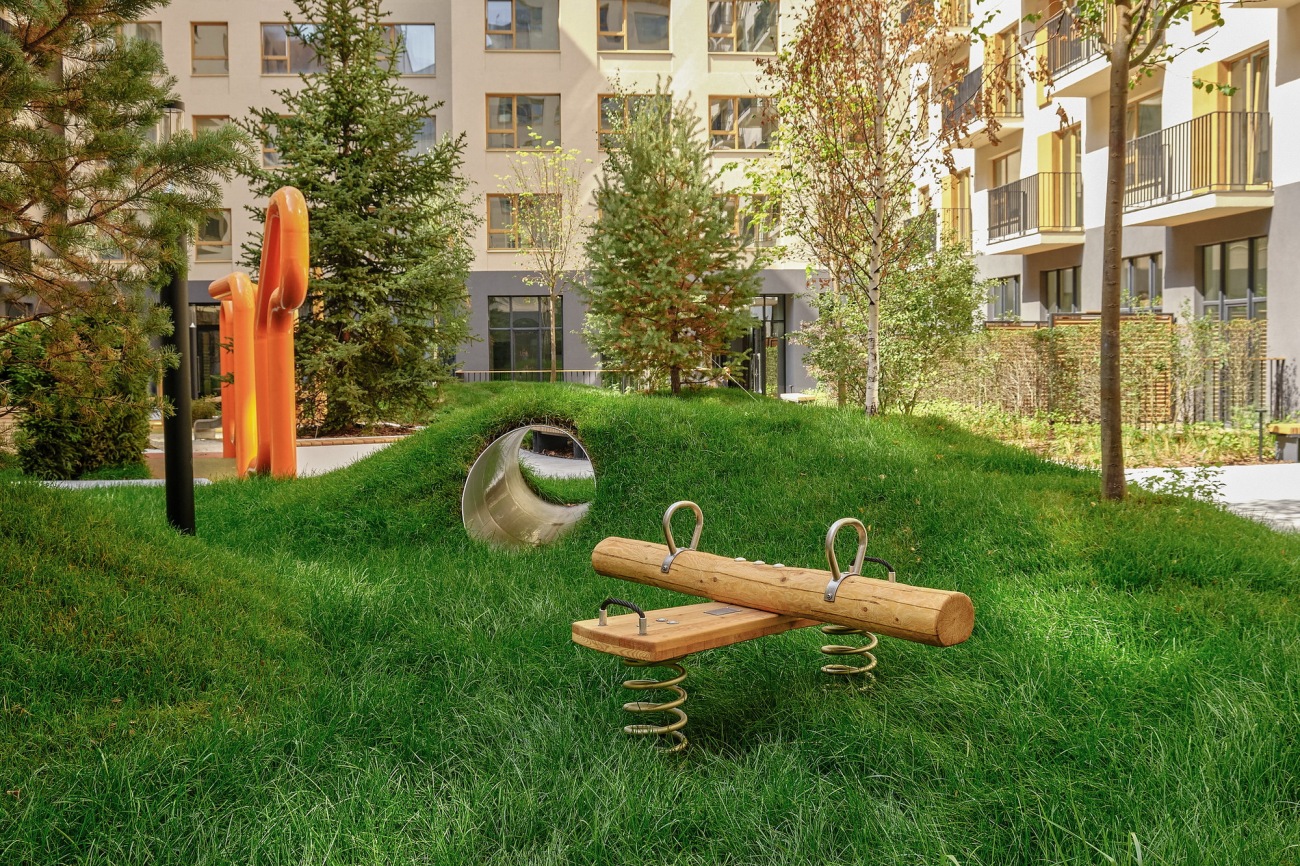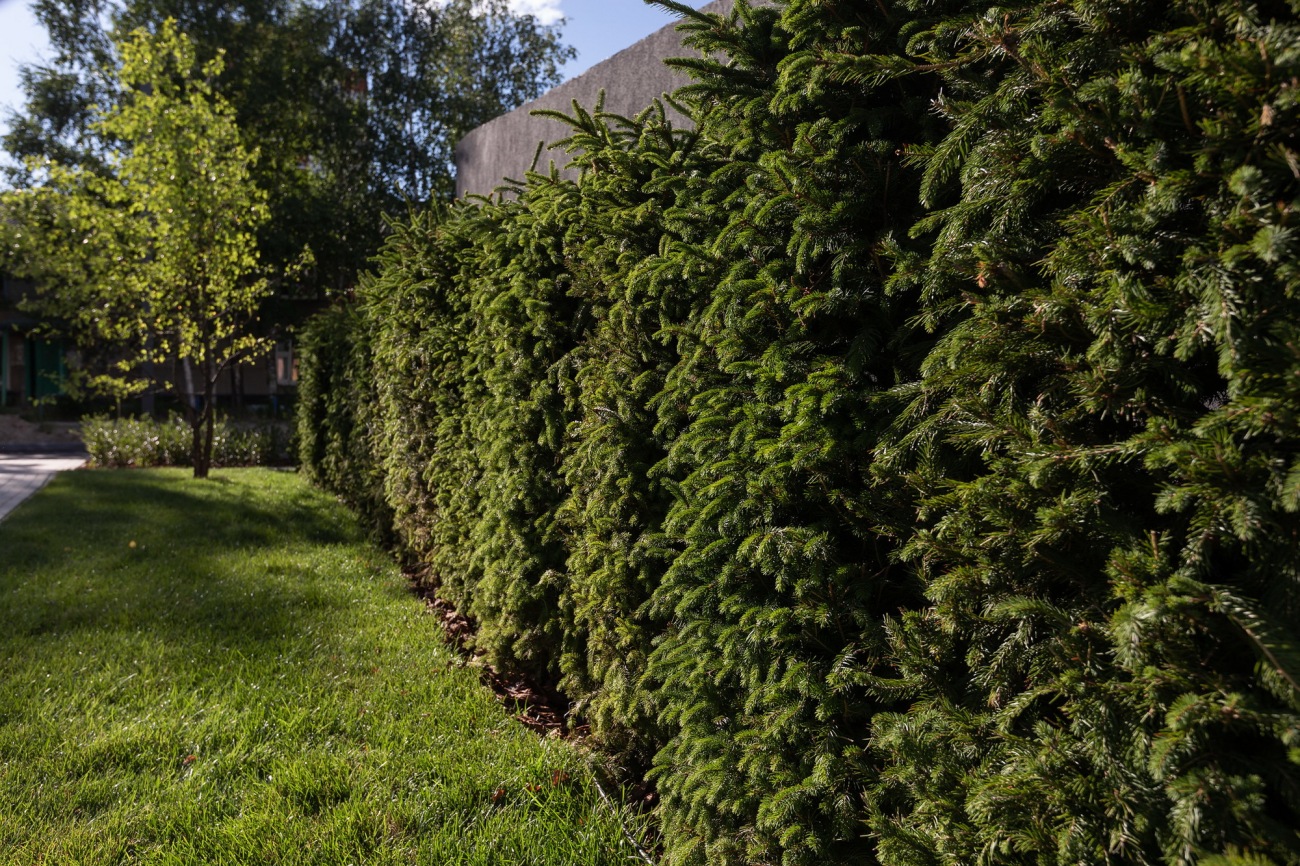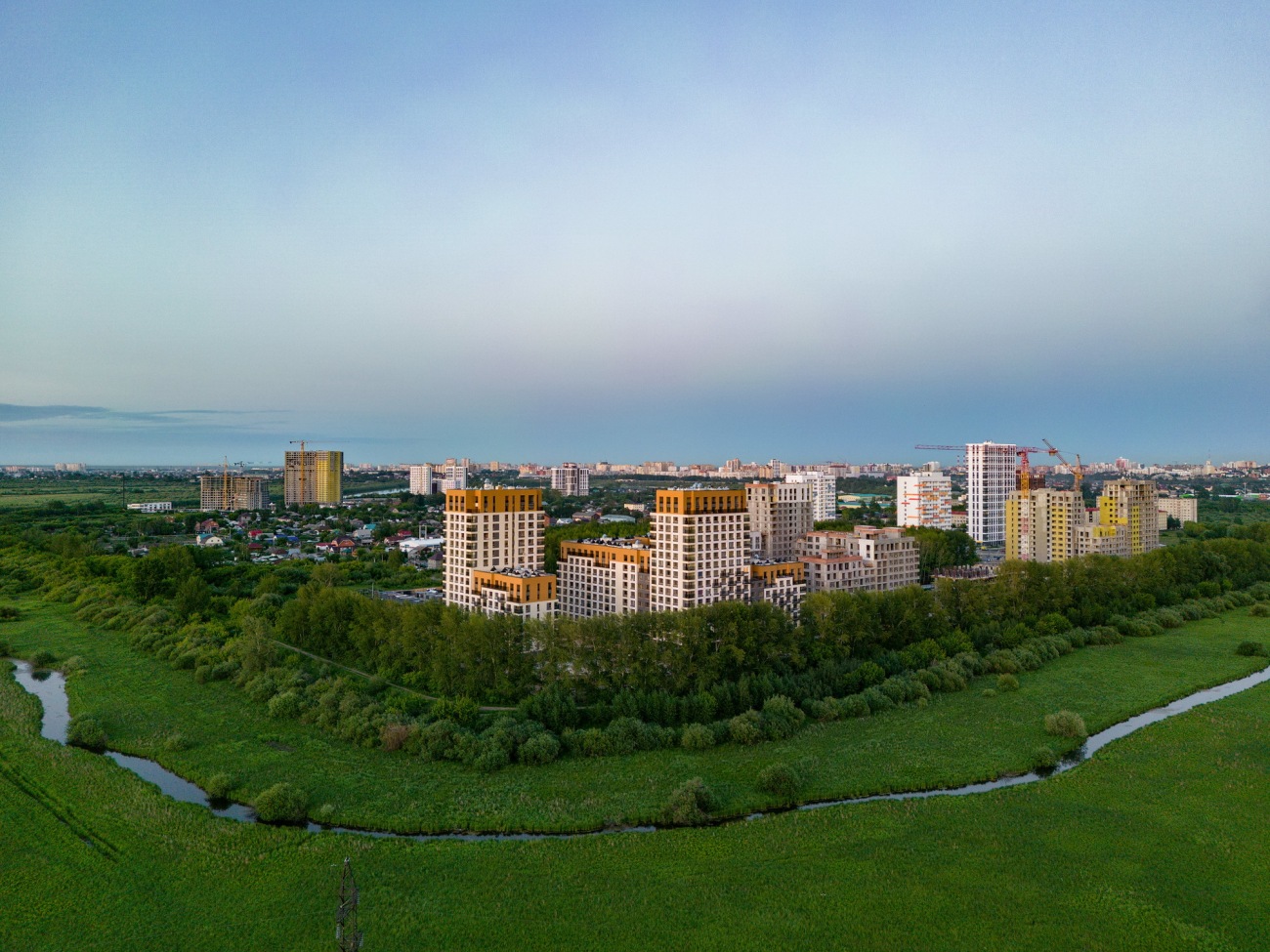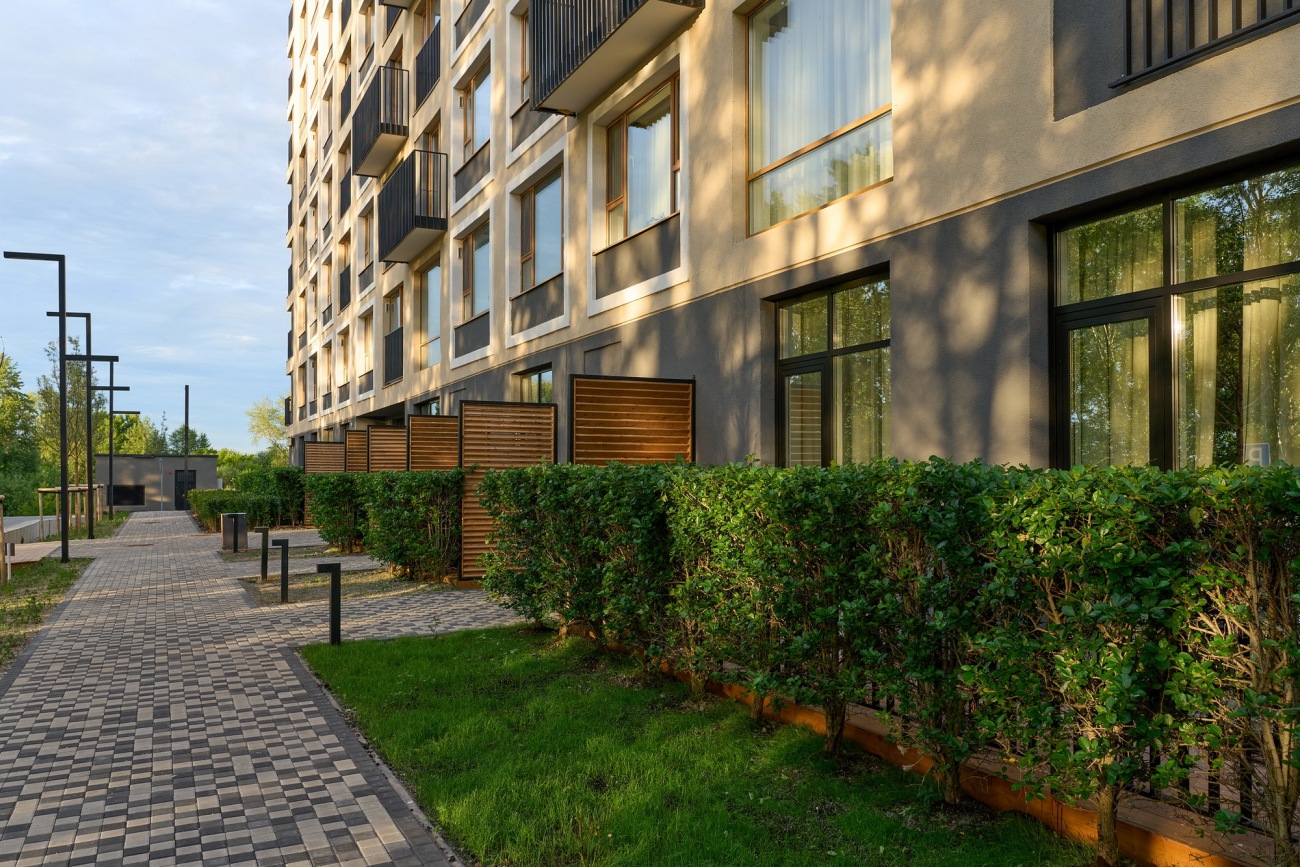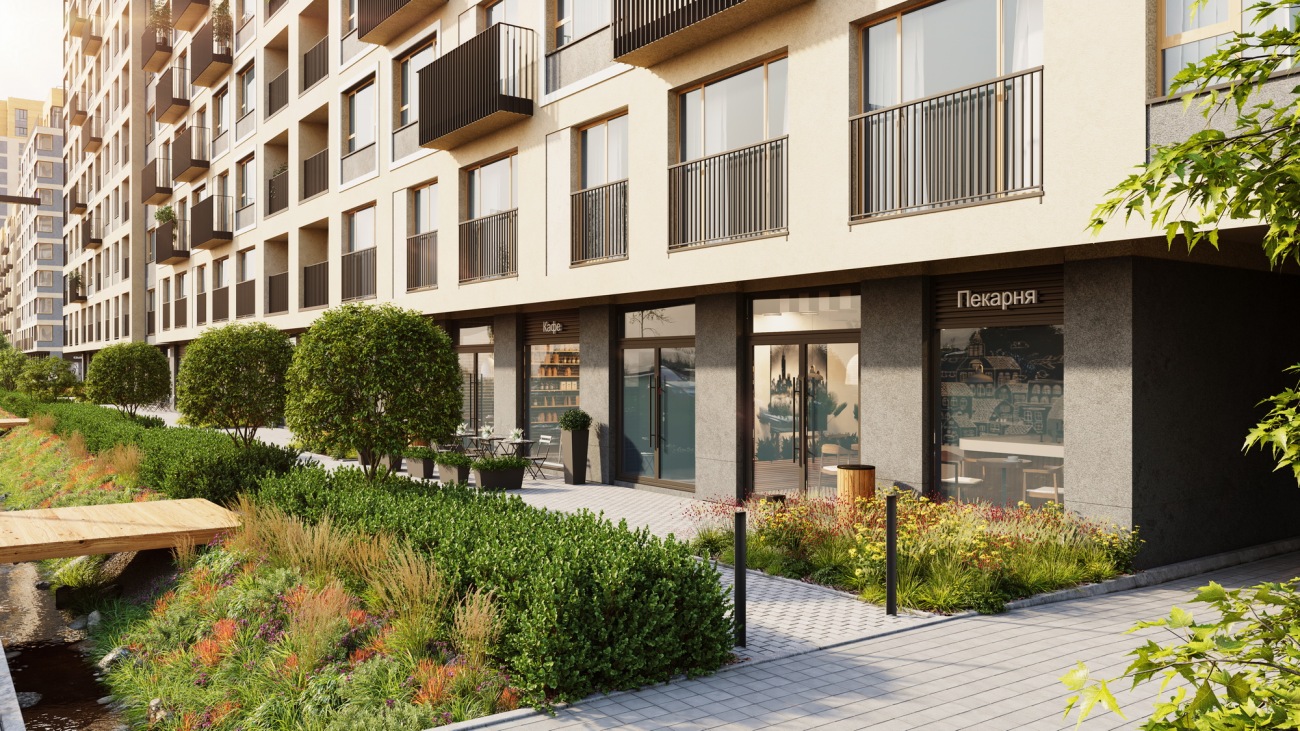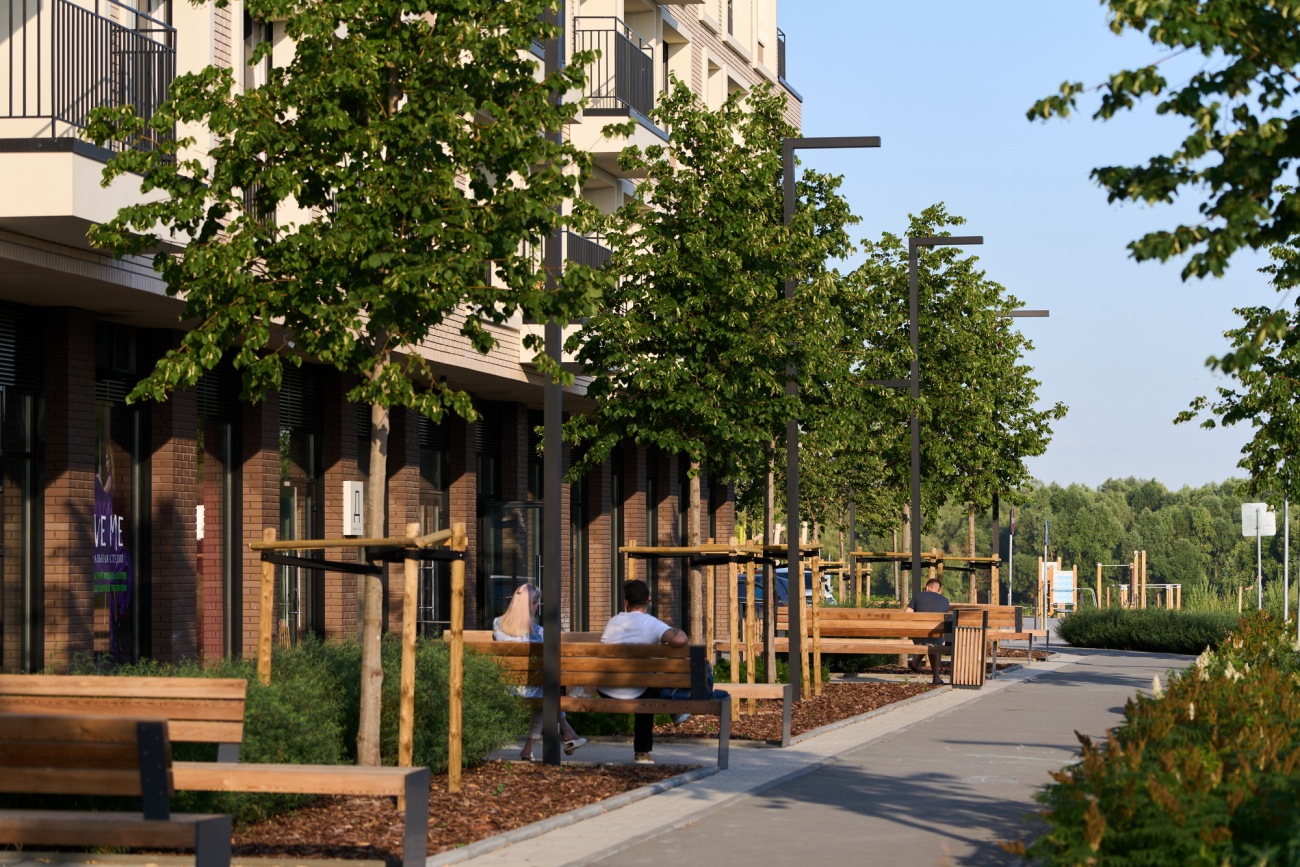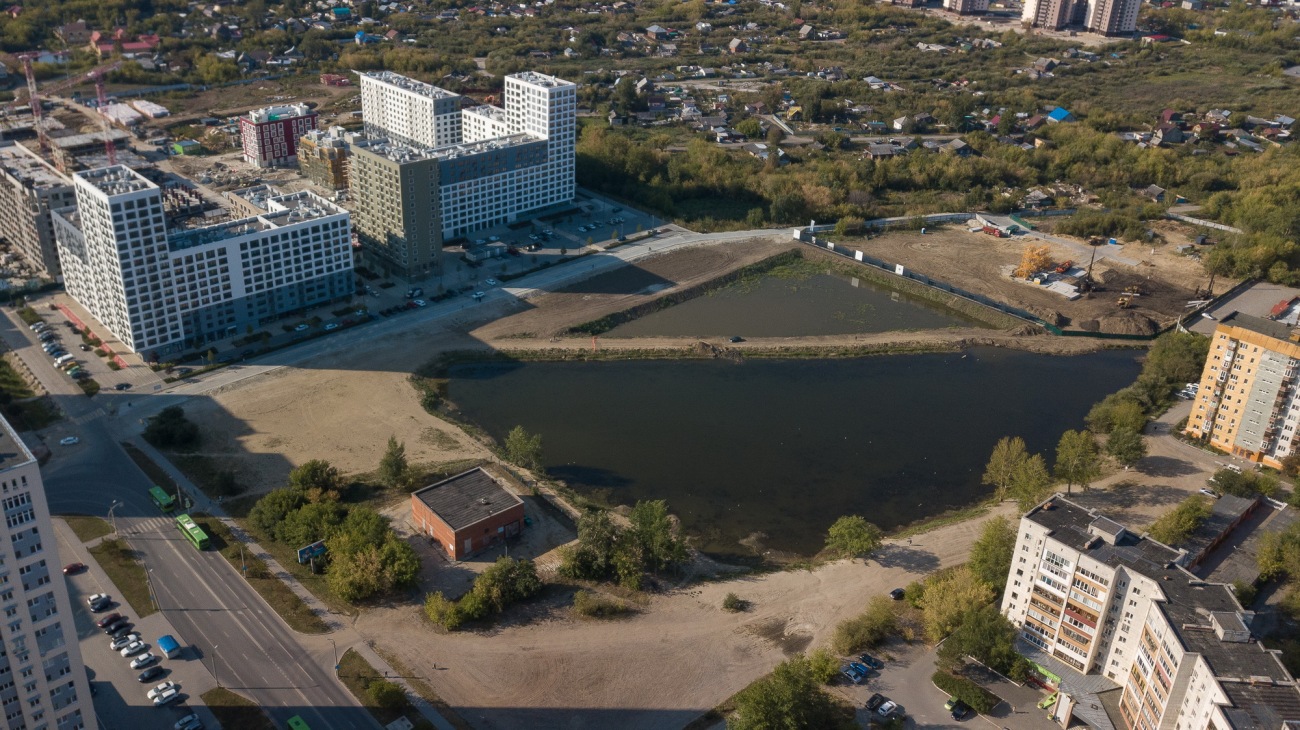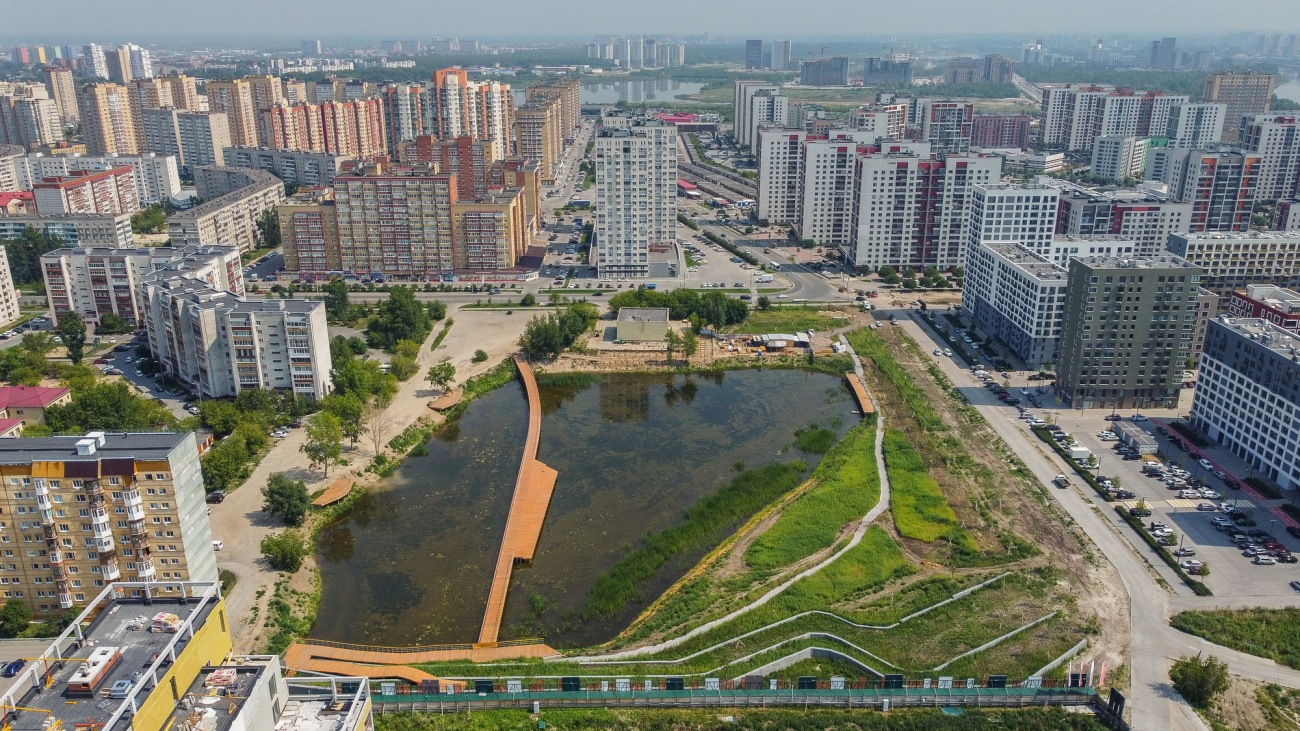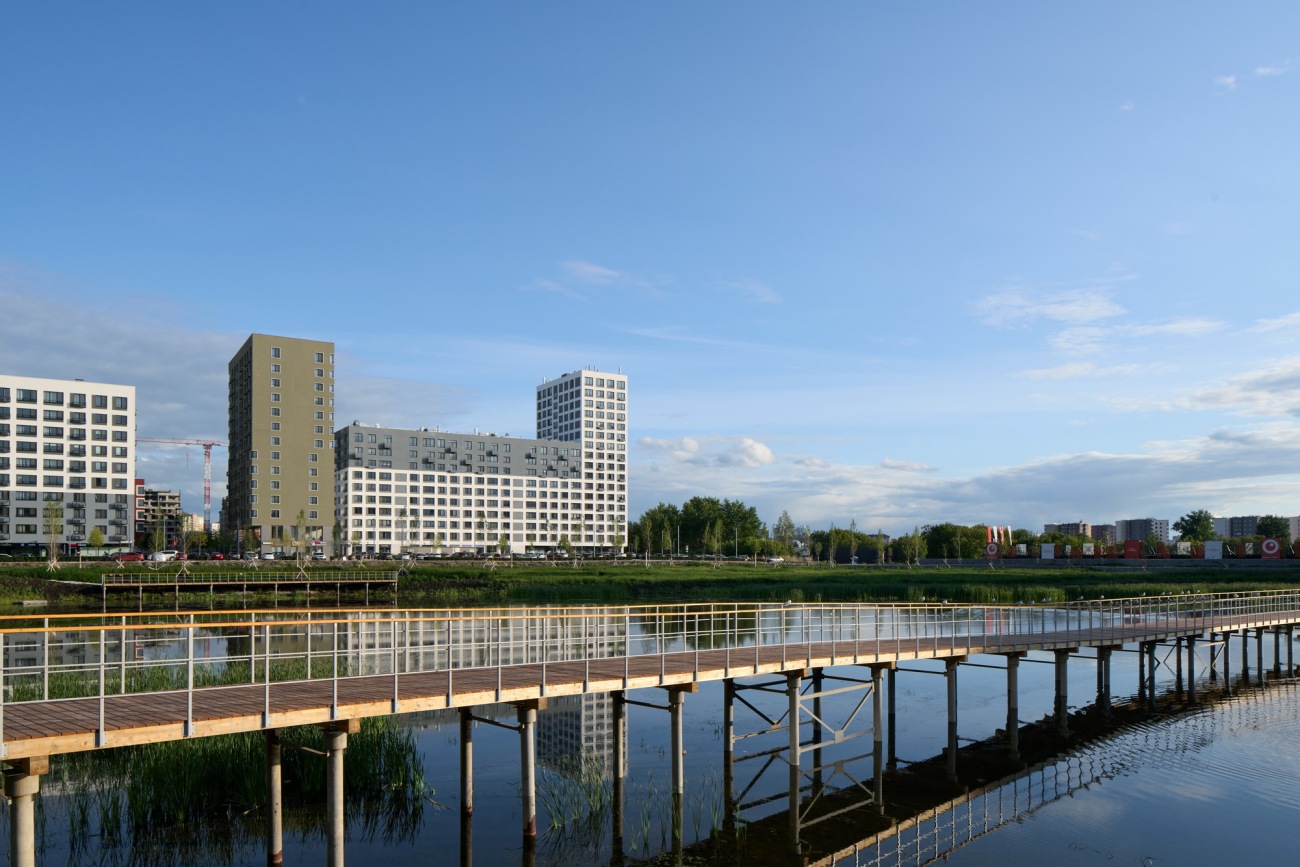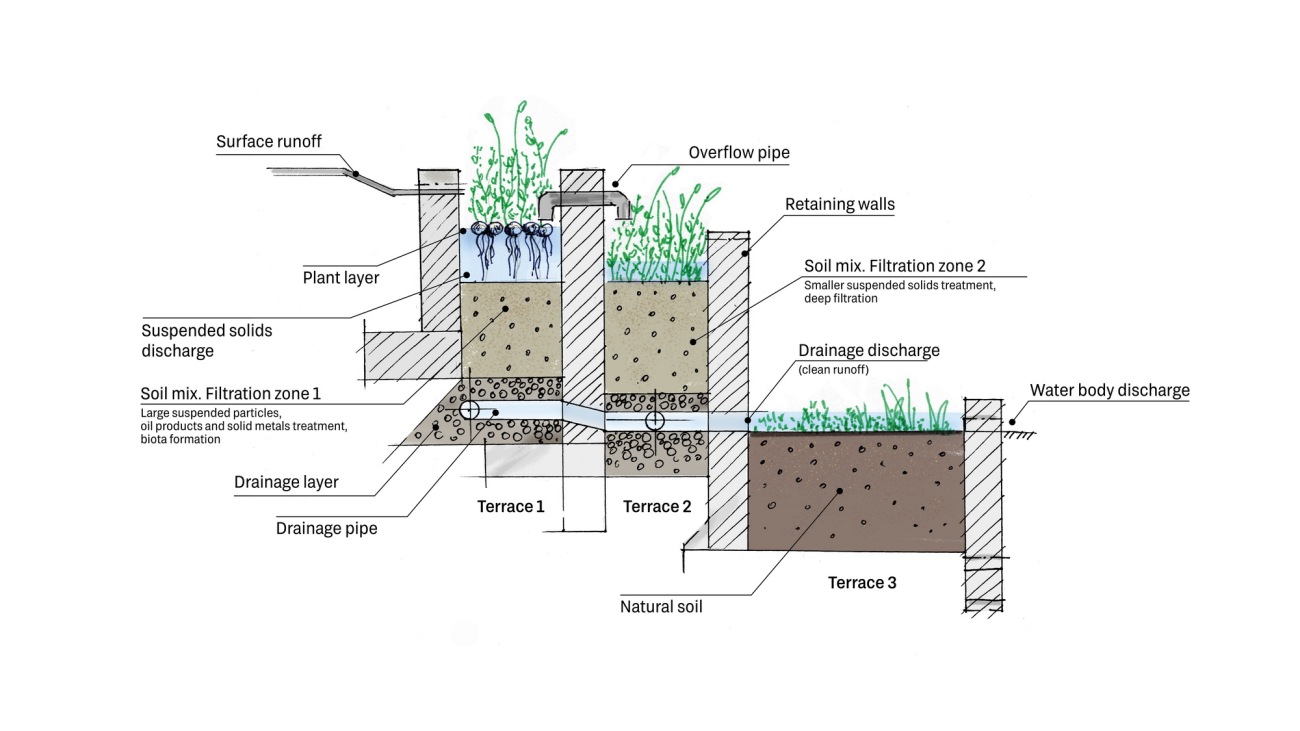自动灌溉系统
Automatic irrigation system
通过推出水管理系统,俄罗斯开发商Brusnika为现代住宅区提供了舒适的城市环境和可持续的景观。通过支持生物多样性和生物量,水有益于气候。
By launching a water management system, Russian developer Brusnika offers a comfortable urban environment and sustainable landscape in modern residential areas. By supporting biodiversity and biomass, water benefits the climate.
水是景观和城市环境的关键可持续性因素之一。它维持了洪泛平原(河流旁边易受洪水影响的平坦区域)的生物多样性并促进了生物量的增长。水管理系统通过整合植物修复设施,例如雨园和生物排水系统(或称为干谷),减少了公用设施的过载。通过在受控生长介质中设计雨园并种植喜水的草本植物,科学证明这是一种有效的方式,可以在住宅区处理、收集和利用地表径流。植物修复设施还可以防止积水,为吸收水分、过滤和储存水分供应了当地的场所,以备后续使用。水资源效率的另一个关键因素是保护邻近的河流和湖泊。
Water constitutes a key sustainability factor for the landscape and urban environment. It maintains biodiversity and boosts biomass in floodplains (areas of flood-prone flat land next to a river). The water management system reduces utility overload by integrating phytoremediation facilities, such as rain gardens and bio drainage systems, or wadi. Designing rain gardens and planting moisture-loving grasses in a controlled growing medium is scientifically proven: it is an effective way to treat, collect and utilise surface runoff in residential areas. Phytoremediation facilities also prevent water logging, providing local spots for absorbing water, filtering and storing it for later use. Another crucial factor of water efficiency is preserving neighbouring rivers and lakes.
“欧洲河岸”,新西伯利亚路堤
“European Riverfront”, Novosibirsk. Embankment
“第一季度”,莫斯科地区庭院
“First Quarter”, Moscow region. Courtyard
“苏霍多尔斯基区”,叶卡捷琳堡庭院
“Sukhodolsky Quarter”, Yekaterinburg. Courtyard
Brusnika在其住宅区使用屋顶和停车场屋顶的雨水径流,让土壤吸收雨水并滋养植物根系。雨水首先通过屋顶漏斗和内部排水管道系统进入雨园的“主体”。收集后,水分渗入经过精心平衡的堆肥中,这是一种由天然成分和添加剂构成的理想混合物。在这个阶段,水中的杂质,如大型和中型悬浮固体,即重金属和有机物质被解放出来。污染物进入土壤混合物,并部分被植物根系吸收和处理。土壤混合物得以更新,净化后的水进入邻近的河流、湖泊或雨水排水系统。从整体水处理的角度来看,该系统的效率达到93%。建筑物和停车场屋顶的总径流量减少到90%。
Brusnika uses rooftop and parking roof runoff in its residential areas after the soil absorbs the rainwater and nourishes plant roots. The runoff first enters the ‘body’ of the rain garden through roof funnels and the system of internal drain pipes. After collection, the water infiltrates into the carefully balanced compost – an optimal mix of natural components and additives. At this stage, it frees from impurities – large and medium suspended solids, i.e. hard metals and organic matter inclusions. Pollutants enter the soil mix and are partly absorbed and processed by plant roots. The soil mix revitalises, and purified water enters a neighbouring river, lake, or storm drain. In terms of overall water treatment, the efficiency of this system is 93%. The total runoff volume from building and parking rooftops reduces to 90%.
Brusnika项目的雨水利用方案
The scheme of rainwater use in Brusnika’s projects
景观工程区分了雨水收集和利用的三个层次。这些是绿色屋顶、交通繁忙的停车场屋顶和街道植物修复设施。
Landscape engineering distinguishes three levels of rainwater collection and usage. These are green roofs, trafficked parking roofs, and street phytoremediation facilities.
绿色屋顶Green roofs
作为任何项目中昂贵的元素,绿色屋顶通常位于建筑物中难以接触的部分,这影响了其维护。最多可能配备有自动灌溉系统,因此通常用于住宅区园林设计的植物是不合适的,它们需要耐旱,并且不需要每天细心照料。
A costly element of any project, a green roof often sits in inaccessible parts of the building, which affects its maintenance. It may be equipped with an automatic irrigation system at most, so plants usually used for landscaping in residential areas are unsuitable – they have to be hardy, with no need to tend them daily.
起初,为了创建广泛的绿色屋顶,Brusnika使用了欧洲的绿色垫子。然而,在大陆亚北极气候中,植物生根缓慢,往往难以茁壮成长。此外,由于成本高昂,这项技术仅限于高端住房。
Initially, to create extensive roofs, Brusnika used European green mats. However, in continental subarctic climates, plants are slow to take root and often fail to thrive. Moreover, due to their high cost, this technology is only limited to upmarket housing.
Brusnika在叶卡捷琳堡的一个项目中的密集型绿色屋顶
Intensive green roof in one of Brusnika’s projects in Yekaterinburg
一种可行的替代方法是种植一系列适应乌拉尔和西伯利亚恶劣气候的草原和草地植物,这些地区的季节温度范围为-30°C至+30°C。我们在俄罗斯叶卡捷琳堡市的“纳涅克拉索娃住宅区”中的一个屋顶上启动了一个试点项目。今年春天,景观设计师种植了当地的乌拉尔植物,将整个屋顶区域分成了六个相等的区域,土壤混合物和排水膜深度各不相同。通过这种方式,他们将得到适合这样的园林设计的完美组合。在植物越冬后,我们将能够在明年春季充分评估实验结果。
A viable alternative is to plant a variety of steppe and meadow communities plants, resistant to the harsh climates of the Urals and Siberia with a range of seasonal temperatures of –30°C до +30°C. We have launched a pilot project on one of the house roofs in the “Na Nekrasova Quarter” in Russian city Yekaterinburg. This spring, landscape architects planted indigenous Ural plants, dividing the whole roof area into six equal plots varying in soil mix and drainage membrane depth. This way, they will derive a perfect formula for such landscaping. We can fully evaluate the experiment results next spring after wintering the plants.
推广屋顶技术的方案饼图结构
The scheme of extensive roof technology. Pie structure
“Na Nekrasova区”,叶卡捷琳堡。广阔的屋顶,种植乌拉尔植物
“Na Nekrasova Quarter”, Yekaterinburg. Extensive roof, planting of Ural plants
“Na Nekrasova区”,叶卡捷琳堡。广阔的屋顶,种植乌拉尔植物
“Na Nekrasova Quarter”, Yekaterinburg. Extensive roof, planting of Ural plants
“Na Nekrasova区”,叶卡捷琳堡。广阔的屋顶,种植乌拉尔植物
“Na Nekrasova Quarter”, Yekaterinburg. Extensive roof, planting of Ural plants
停车场交通繁忙的屋顶Parking trafficked roof
Brusnika的住宅区通常由闭合的建筑群组成,一楼是面向街道的零售区,而位于停车场屋顶上的内部庭院则位于一楼水平。因此,从根本上说,对屋顶进行园林设计就等于对庭院进行园林设计。
Brusnika’s residential quarters generally comprise closed-up blocks, a street-facing retail zone on the ground floor, and the inner courtyard on the first-floor level sited on the parking rooftop. So basically, landscaping the roof equals landscaping the yard.
“南区”,叶卡捷琳堡。停车场屋顶上的庭院
“Southern Quarters”, Yekaterinburg. A courtyard on the parking roof
“欧洲区”,秋明。停车场屋顶上的庭院
“European Quarter”, Tyumen. A courtyard on the parking roof
根据欧洲开发商的经验,Brusnika在停车场屋顶的绿色庭院中的配方包含了65-70%的植物,其中30%是灌木,20%是草坪,20%是草地和多年生植物,5%是大型树木,其余25%为硬质铺装。除了美化外,广泛的绿化还可以净化空气,遮挡风,提供阴凉,并促进庭院内舒适的环境。例如,针叶树会产生植物杀菌物质-天然化合物,可以杀灭细菌和对抗空气污染。为了给庭院中的植物浇水,我们已经改造了地表漏斗,用于收集雨水和自动灌溉。
Based on the experience of European developers, Brusnika’s formula for a green courtyard on the parking roof contains 65-70% of plants, where 30% are shrubs, 20% – lawns, 20% – grasses and perennials, 5% – large-sized trees and the remaining 25% – hard surfacing. Except beautification, extensive greenery purifies the air, shelters the wind, provides shade and promotes a comfortable environment inside the yard. For example, conifers produce phytoncides – natural compounds killing bacteria and fighting air pollution. To water plants in the yard, we have refurbished surface funnels for water collection and automatic irrigation.
针叶树分泌植物毒素,形成密集的树篱
Conifers exude phytoncides and create a dense hedge
街道植物修复设施
Street phytoremediation facilities
这些包括雨水花园和生物排水渠,也被称为wadi。这些功能性的绿色缓冲区还能集中地表径流并引导其供养附近的植物。它们足够减少了公用设施的负荷,径流达到了暴雨排水管的90%。通过不使用复杂的化学物质进行道路清洁,我们防止了水污染的发生。
These include rain gardens and bio drainage channels, known as wadi. These functional green buffers also concentrate surface runoff and channel it to feed nearby plants. They sufficiently reduce utility load, with runoff reaching storm drains drop to 90%. By using no complex chemicals for street cleaning, we prevent water pollution.
秋明“Oktyabrsky区”。全景和泛滥平原草地
“Oktyabrsky Quarter”, Tyumen. General view and floodplain meadows
位于俄罗斯城市秋明的“Oktyabrsky Quarter”完成了首条生物排水渠道,经受了几个季节的考验并证明了其高效性。这些干谷位于该地区周边的专用缓冲区内,它们在降雨、雪融化以及当地图拉河的季节性溢流期间收集水源,防止了集水区域的积水。通过在渠道边坡种植抗洪草地、灌木和树木,它们充当了生物泵,吸收和蒸发水源,从而避免了洪水的发生。与雨水花园不同,干谷仅有一个渗透土壤混合斜坡来吸收杂质。为了避免溢出,溢流管将多余的水源引导到暴雨排水管道中。
The first bio-drainage channels completed in “Oktyabrsky Quarter” in Russian city Tyumen have weathered several seasons and proved their efficiency. Built in dedicated buffers along the quarter perimeter, wadis collect water during rains, snow melting and seasonal overflow of the local Tura River, preventing water logging in the catchment area. With flood-resistant grasses, shrubs and trees planted along the slopes of the channels, they act as a biological pump, soaking up and evaporating water, which prevents flooding. Unlike rain gardens, wadis have only one infiltration soil mix slope to absorb impurities. To avoid spillovers, overflow pipes channel excess water to storm drains.
秋明“Oktyabrsky区”。大街
“Oktyabrsky Quarter”, Tyumen. Street
秋明“Oktyabrsky Quarter”的干谷系统
The wadi system in “Oktyabrsky Quarter”, Tyumen
秋明“Oktyabrsky区”干谷系统方案
The scheme of the wadi system in “Oktyabrsky Quarter”, Tyumen
在俄罗斯城市新西伯利亚的“欧洲河滨”住宅区(Brusnika的项目)的一栋房屋中首次出现了街道雨水花园,用于引导邻近人行道街道的径流。它们的特点是土壤混合物的深度 - 1.3米,而不是通常的2米。这是因为水源来自行人道路的铺装和建筑立面,而不是屋顶。径流的组成影响着污染的性质 - 专家们仍在研究系统中的土壤混合物。栽种在上面的喜湿植物和树木的根系吸收杂质。
Street rain gardens first appeared in one of the houses of “European Riverfront” residential area (Brusnika’s project) in Russian city Novosibirsk to channel runoff from the neighbouring pedestrian street. Their feature is the depth of the soil mix – 1,3 instead of the customary 2 metres. It is because water collection comes from the pedestrian street tile paving and building frontage, avoiding the rooftop. The runoff composition affects the nature of pollution – experts are still studying the soil mix in the system. The root system of moisture-loving plants and trees planted on top absorbs impurities.
剖面图。街道雨水花园系统
Sectional view. Street rain garden system
“欧洲河岸”,新西伯利亚大街
“European Riverfront”, Novosibirsk. Street
供水水体
Feeding water bodies
排放雨水径流的另一种方法是将其引导到最近的水体以及雨水沟。以布鲁斯尼卡的另一个项目——秋明的“湖边之家”为例:该地区内的雨水花园为邻近的季霍耶湖提供水源。雨水径流渗入雨水花园和植物修复系统的几个露台,然后排入湖中。它保持着水的平衡,湖泊从流入的清水中受益,清水为附近的植物提供食物,并维持野生动物的生存。为了实现这项技术,Brusnika自2021年以来一直在振兴Tikhoye湖。开发商已经清理了湖盆,通过人工坝抽取了26000立方米的水,从湖底清除了20000立方米的淤泥,将湖底从1.4米加深到2.5米,并竖起了支撑墙。现在正在进行景观美化:湖泊正在配备步行道和自行车道。
An alternative way to discharge rainwater runoff is by channelling it to the nearest water body in addition to storm drains. Take one more project of Brusnika — “House by the Lake” in Tyumen: rain gardens inside the area feed the neighbouring Tikhoye Lake. The rainwater runoff infiltrates into the rain gardens and several terraces of the phytoremediation system before discharging into the lake. It maintains water balance, where the lake benefits from an inflow of clear water, which feeds nearby plants and sustains wildlife. To realise this technology Brusnika has being revitalized Tikhoye Lake since 2021. The developer already cleaned the basin, removed 20 000 cubic metres silt from the bottom of the lake by pumping 26 000 cubic metres of water through an artificial dam, deepened the lake from 1.4 to 2.5 metres and erected supporting walls. Now landscaping in progress: lake is equipping with pedestrian paths and cycling lanes.
秋明提湖。2021年,通过人工水坝抽水清洁水池
Tikhoe Lake, Tyumen. Cleaning the basin by pumping water through an artificial dam, 2021
秋明提湖。正在进行景观美化,2023年夏季
Tikhoe Lake, Tyumen. Landscaping in progress, summer 2023
秋明提湖。正在进行景观美化,2023年夏季
Tikhoe Lake, Tyumen. Landscaping in progress, summer 2023
秋明提湖。正在进行景观美化,2023年夏季
Tikhoe Lake, Tyumen. Landscaping in progress, summer 2023
秋明Tikhoye湖植物修复方案
Scheme of phytoremediation on Tikhoye Lake, Tyumen
作为Brusnika的产品标准的一个重要组成部分,景观可持续性是全球城市发展中不可忽视的优先事项,符合联合国应对气候变化的目标。通过实施全面的水管理和植物修复计划,该公司已成功实现了以下目标:
•通过创建降雨收集、处理和利用的生物循环来分流径流。
•将绿色屋顶的面积增加一倍。
•缩小污水径流收集器的直径,创造几乎干净的径流。
•在街道和庭院径流之间创建一个绿色缓冲区。
•促进项目的生态方面符合BREM社区标准,并提高其可持续性。
An essential part of the product standard in Brusnika, landscape sustainability is an undeniable priority in urban development across the globe, in line with the UN's goal to combat climate change. By implementing a comprehensive water management and phytoremediation programme, the company has managed to achieve the following objectives:
•To divert runoff by creating a biological cycle of rainfall collection, treatment and utilisation.
•To double the area of green roofs.
•To narrow the diameter of foul runoff collectors and create virtually clean runoff.
•To create a green buffer between the street and courtyard runoff.
To boost the ecological aspect of projects in compliance with BREEM Communities standards and enhance their sustainability.
更新日期:2023-08-08 14:38:58
非常感谢 Brusnika 带来的精彩项目, 查阅更多Appreciations towards Brusnika for sharing wonderful work on hhlloo. Click to see more works!
